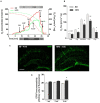Hippocampal Function Is Impaired by a Short-Term High-Fat Diet in Mice: Increased Blood-Brain Barrier Permeability and Neuroinflammation as Triggering Events
- PMID: 34803583
- PMCID: PMC8600238
- DOI: 10.3389/fnins.2021.734158
Hippocampal Function Is Impaired by a Short-Term High-Fat Diet in Mice: Increased Blood-Brain Barrier Permeability and Neuroinflammation as Triggering Events
Abstract
Worldwide, and especially in Western civilizations, most of the staple diets contain high amounts of fat and refined carbohydrates, leading to an increasing number of obese individuals. In addition to inducing metabolic disorders, energy dense food intake has been suggested to impair brain functions such as cognition and mood control. Here we demonstrate an impaired memory function already 3 days after the start of a high-fat diet (HFD) exposure, and depressive-like behavior, in the tail suspension test, after 5 days. These changes were followed by reduced synaptic density, changes in mitochondrial function and astrocyte activation in the hippocampus. Preceding or coinciding with the behavioral changes, we found an induction of the proinflammatory cytokines TNF-α and IL-6 and an increased permeability of the blood-brain barrier (BBB), in the hippocampus. Finally, in mice treated with a TNF-α inhibitor, the behavioral and BBB alterations caused by HFD-feeding were mitigated suggesting that inflammatory signaling was critical for the changes. In summary, our findings suggest that HFD rapidly triggers hippocampal dysfunction associated with BBB disruption and neuroinflammation, promoting a progressive breakdown of synaptic and metabolic function. In addition to elucidating the link between diet and cognitive function, our results might be relevant for the comprehension of the neurodegenerative process.
Keywords: bioenergetics; blood–brain barrier; cognition; depression; high fat diet; memory; mitochondria; neuroinflammation.
Copyright © 2021 de Paula, Brunetta, Engel, Gaspar, Velloso, Engblom, de Oliveira and de Bem.
Conflict of interest statement
The authors declare that the research was conducted in the absence of any commercial or financial relationships that could be construed as a potential conflict of interest.
Figures





Similar articles
-
Endothelial Adora2a Activation Promotes Blood-Brain Barrier Breakdown and Cognitive Impairment in Mice with Diet-Induced Insulin Resistance.J Neurosci. 2019 May 22;39(21):4179-4192. doi: 10.1523/JNEUROSCI.2506-18.2019. Epub 2019 Mar 18. J Neurosci. 2019. PMID: 30886019 Free PMC article.
-
Normal diet Vs High fat diet - A comparative study: Behavioral and neuroimmunological changes in adolescent male mice.Metab Brain Dis. 2018 Feb;33(1):177-190. doi: 10.1007/s11011-017-0140-z. Epub 2017 Nov 3. Metab Brain Dis. 2018. PMID: 29101600
-
Time-dependent behavioral, neurochemical, and metabolic dysregulation in female C57BL/6 mice caused by chronic high-fat diet intake.Physiol Behav. 2016 Apr 1;157:196-208. doi: 10.1016/j.physbeh.2016.02.007. Epub 2016 Feb 4. Physiol Behav. 2016. PMID: 26852949 Free PMC article.
-
High fat diet and its effects on cognitive health: alterations of neuronal and vascular components of brain.Physiol Behav. 2021 Oct 15;240:113528. doi: 10.1016/j.physbeh.2021.113528. Epub 2021 Jul 11. Physiol Behav. 2021. PMID: 34260890 Review.
-
Glutamate receptor antibodies in neurological diseases: anti-AMPA-GluR3 antibodies, anti-NMDA-NR1 antibodies, anti-NMDA-NR2A/B antibodies, anti-mGluR1 antibodies or anti-mGluR5 antibodies are present in subpopulations of patients with either: epilepsy, encephalitis, cerebellar ataxia, systemic lupus erythematosus (SLE) and neuropsychiatric SLE, Sjogren's syndrome, schizophrenia, mania or stroke. These autoimmune anti-glutamate receptor antibodies can bind neurons in few brain regions, activate glutamate receptors, decrease glutamate receptor's expression, impair glutamate-induced signaling and function, activate blood brain barrier endothelial cells, kill neurons, damage the brain, induce behavioral/psychiatric/cognitive abnormalities and ataxia in animal models, and can be removed or silenced in some patients by immunotherapy.J Neural Transm (Vienna). 2014 Aug;121(8):1029-75. doi: 10.1007/s00702-014-1193-3. Epub 2014 Aug 1. J Neural Transm (Vienna). 2014. PMID: 25081016 Review.
Cited by
-
Short-term high-fat diet alters the mouse brain magnetic resonance imaging parameters consistently with neuroinflammation on males and metabolic rearrangements on females. A pre-clinical study with an optimized selection of linear mixed-effects models.Front Neurosci. 2022 Nov 24;16:1025108. doi: 10.3389/fnins.2022.1025108. eCollection 2022. Front Neurosci. 2022. PMID: 36507349 Free PMC article.
-
Comparison Between Two Divergent Diets, Mediterranean and Western, on Gut Microbiota and Cognitive Function in Young Sprague Dawley Rats.Gut Microbes Rep. 2024;1(1):1-21. doi: 10.1080/29933935.2024.2439490. Epub 2024 Dec 18. Gut Microbes Rep. 2024. PMID: 39916748
-
Sex-dependent effects of a high-fat diet on the hypothalamic response in mice.Biol Sex Differ. 2025 Feb 25;16(1):17. doi: 10.1186/s13293-025-00699-3. Biol Sex Differ. 2025. PMID: 40001261 Free PMC article.
-
The Impact of Maternal Obesity and Deprivation On Energy Metabolism, Oxidative Stress and Brain Antioxidant Defense in the Neurodevelopment of Offspring in the Short, Medium and Long Term.Mol Neurobiol. 2025 May 24. doi: 10.1007/s12035-025-05070-6. Online ahead of print. Mol Neurobiol. 2025. PMID: 40411684
-
1-Methyltryptophan treatment ameliorates high-fat diet-induced depression in mice through reversing changes in perineuronal nets.Transl Psychiatry. 2024 May 30;14(1):228. doi: 10.1038/s41398-024-02938-4. Transl Psychiatry. 2024. PMID: 38816357 Free PMC article.

